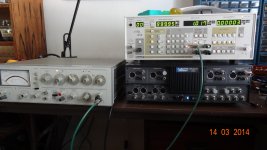Regarding LT1229
Hi,
Can you please explain the feedback and AGC portion of the circuit? I am not reaaly understood what's the functionality of this LT1229 in the design?
With Regards,
Akh
Hi,
Can you please explain the feedback and AGC portion of the circuit? I am not reaaly understood what's the functionality of this LT1229 in the design?
With Regards,
Akh
Hello Turbon,
The LT1229 is the two OPAMP version of the LT1230 that have four.
For an unknown reason the LT1230 is become harder to find but not obsolete as indicated on LT web site.
There is no change in parts values, but power supply is made differently.
You can see schematics on first page of the topic.
On the other side, you can made a V2 with 1kHz operation as i made on V3 PCB.
And no worry, there is no plan to change ERMSDCV2 PCB.
Regards.
Frex
I meant LT1228 sorry for the confusion.Yes.....But the app note explains more on the super amplifier topology than the oscillator itself.. I clearly understands the amp topology. But didnt clearly understood Afeedback and AGC circuit, especially whats happening with LT1229
I meant LT1228. Sorry for the confusion
Hi,
Can you please explain the feedback and AGC portion of the circuit? I am not reaaly understood what's the functionality of this LT1229 in the design?
With Regards,
Akh
Hello Akh,
The LT1228 is a VCA, a "voltage controlled amplifier". The gain of the VCA is proportional to the current at Iset pin.
You can see it as an analog multiplier. It allow the precise closed loop amplitude control of the oscillator.
The DC current on the Iset pin reflect the output amplitude of the oscillator and the the VCA inject just what
the oscillator need to maintain the oscillator at this amplitude level. It act as parallel resistor with R8.
In many others design, this thing is done using opto-resistor (LDR+LED).
Regards.
Frex
The LT1228 is a VCA, a "voltage controlled amplifier". The gain of the VCA is proportional to the current at Iset pin.
You can see it as an analog multiplier. It allow the precise closed loop amplitude control of the oscillator.
The DC current on the Iset pin reflect the output amplitude of the oscillator and the the VCA inject just what
the oscillator need to maintain the oscillator at this amplitude level. It act as parallel resistor with R8.
In many others design, this thing is done using opto-resistor (LDR+LED).
Regards.
Frex
EOSC10KV3 Audio-Precision SYS2722 THD results from Samuel
Hello all,
This week Samuel as made some measurements on the 10 kHz units i sent to him.
After a little mistake from me about adjustment procedure, he finally found the way to adjust it.
I thank him very much for his patience and his effort to realize these serious measurements.
He's test has been done at 1Vrms, as for my previous tests.
He's first test has been done connecting directly the EOSC10kV3 outputs to the input of
Audio-Precision SYS-2722 analyzer. He noticed then, that all harmonics coming mainly
from the SYS2722 itself.
Then, to extend measurement capability, he has make others tests using a (very good)
passive notch filter between the oscillator and analyzer to avoid SYS2722 front end THD.
The attenuation coming from the filter at harmonics frequency is compensated by the
SYS2722 to show real amplitude level.
The resulting FFT measurements on each channel is showed below :
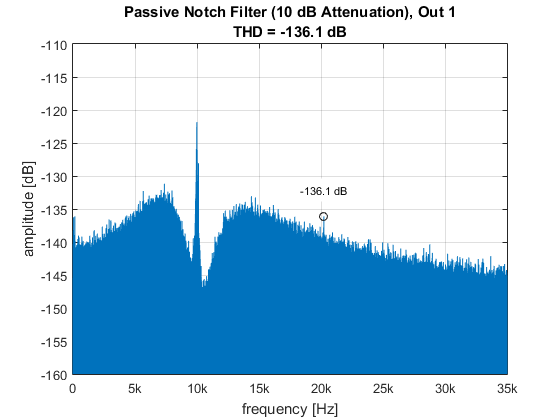
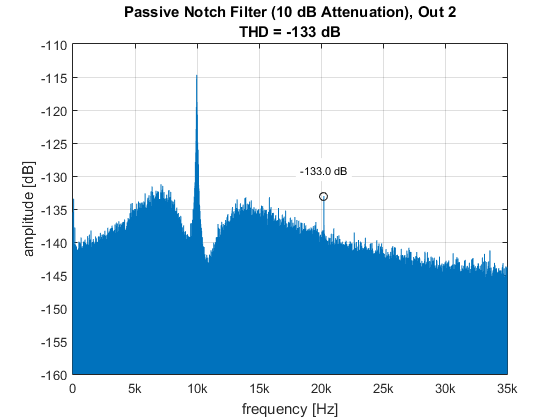
As we can see, the THD products is extremely low (as i expected). Much below ppm level.
The THD calculation give -136 dBV or 0.00005 % !
With only H2 visible and all the others flooded in noise floor.
I noticed also, that these results are very near my own measurements i posted on page 2
of the thread with my notch+AKM ADC setup.
It's a good new, and make me very confident about my setup accuracy.
Samuel has keep the oscillator for now, and maybe he will make some others measurements
at higher output level.
Also, these days I successfully used a lock-in injection to lock the oscillator frequency
to a high precision oscillator (DDS) and this without affecting THD.
My objective is to trying to make more accurate FFT reading by getting integer number of period
of the oscillator as the FTT sampling time / Number of FFT bins.
The locking is ok, but the frequency windows where is it possible is very narrow (about +/-1Hz),
because of high Q of the the oscillator.
I will continue to make some tests by using the ADC master clock itself to synchronize the oscillator
frequency to the right integer multiple.
(For those that are interested i recommend the reading of this EDN article).
Regards.
Frex
Hello all,
This week Samuel as made some measurements on the 10 kHz units i sent to him.
After a little mistake from me about adjustment procedure, he finally found the way to adjust it.
I thank him very much for his patience and his effort to realize these serious measurements.
He's test has been done at 1Vrms, as for my previous tests.
He's first test has been done connecting directly the EOSC10kV3 outputs to the input of
Audio-Precision SYS-2722 analyzer. He noticed then, that all harmonics coming mainly
from the SYS2722 itself.
Then, to extend measurement capability, he has make others tests using a (very good)
passive notch filter between the oscillator and analyzer to avoid SYS2722 front end THD.
The attenuation coming from the filter at harmonics frequency is compensated by the
SYS2722 to show real amplitude level.
The resulting FFT measurements on each channel is showed below :


As we can see, the THD products is extremely low (as i expected). Much below ppm level.
The THD calculation give -136 dBV or 0.00005 % !
With only H2 visible and all the others flooded in noise floor.
I noticed also, that these results are very near my own measurements i posted on page 2
of the thread with my notch+AKM ADC setup.
It's a good new, and make me very confident about my setup accuracy.
Samuel has keep the oscillator for now, and maybe he will make some others measurements
at higher output level.
Also, these days I successfully used a lock-in injection to lock the oscillator frequency
to a high precision oscillator (DDS) and this without affecting THD.
My objective is to trying to make more accurate FFT reading by getting integer number of period
of the oscillator as the FTT sampling time / Number of FFT bins.
The locking is ok, but the frequency windows where is it possible is very narrow (about +/-1Hz),
because of high Q of the the oscillator.
I will continue to make some tests by using the ADC master clock itself to synchronize the oscillator
frequency to the right integer multiple.
(For those that are interested i recommend the reading of this EDN article).
Regards.
Frex
Hi Frex,
Mine are almost running. There are some parts I am having difficulty sourcing. Resistors if you can believe that. The semiconductors are in transit, but they won't do any good without those couple parts. I'm trying to source from other vendors, but Digikey was also missing the parts needed. Mouser simply do not stock some in North America. The hunt continues ...
I'm going to mount these in a rack enclosure (I have a 1U that I can re-purpose), they will be double boxed, using a fixed low noise power supply. So I hope for really good performance. The output jacks may be mounted off the boards, depending on how the mechanical stuff goes.
I have to say that these boards are excellent quality. Did most of the soldering today - still have a stiff neck.
Thank you for this excellent project! Will you do the same for the notch filter(s)? The passive notch filters sound like a great idea too.
-Chris
Mine are almost running. There are some parts I am having difficulty sourcing. Resistors if you can believe that. The semiconductors are in transit, but they won't do any good without those couple parts. I'm trying to source from other vendors, but Digikey was also missing the parts needed. Mouser simply do not stock some in North America. The hunt continues ...
I'm going to mount these in a rack enclosure (I have a 1U that I can re-purpose), they will be double boxed, using a fixed low noise power supply. So I hope for really good performance. The output jacks may be mounted off the boards, depending on how the mechanical stuff goes.
I have to say that these boards are excellent quality. Did most of the soldering today - still have a stiff neck.
Thank you for this excellent project! Will you do the same for the notch filter(s)? The passive notch filters sound like a great idea too.
-Chris
Hello Jasse,
I don't think it's necessary, and Samuel has already spend much of his time to made extensive
tests with the 10kHz one. His measurement confirm the validity of my setup so
i'm really very confident about my 1kHz measurements.
Chris,
If you have a problem to find resistors, you can of course use others.
For best performance, is is recommended to use thin film type. (No carbon !)
Size 1206 will fit very well with Melf pattern, 805 is a little bit small but can be also soldered.
I will look with pleasure the final results of your PCB's integration !
Richard,
As you i own a 339A, but i don't have mod it yet. So, i don't know if the famous dedicated wiki
page about the 339 mod is become again available. You know ?
Samuel returned me the 10kHz oscillator (on the road) and he has done many others measurements
on the EOSC10KV3 at others level, from 1 ,2,3 and 4Vrms on each output.
I will post these results soon, i'm very busy right now.
I think it is very difficult to create a real correction curve. Samuel can use a very deep notch filter
(i'm really impressed by his notch depth, probably auto-tuned with PLL) so the level at analyzer
input is extremely low giving THD contribution negligible.
With my setup, to show harmonics i need to add much gain and my notch filter attenuate (only)
to about -70dB so the level at the input of my ADC is much higher (about -20dBV).
Anyway, i alway tried to measure THD at a given level equal to notch attenuation to verify that
there is no (or negligible) THD contribution in signal chain.
Regards.
Frex
I don't think it's necessary, and Samuel has already spend much of his time to made extensive
tests with the 10kHz one. His measurement confirm the validity of my setup so
i'm really very confident about my 1kHz measurements.
Chris,
If you have a problem to find resistors, you can of course use others.
For best performance, is is recommended to use thin film type. (No carbon !)
Size 1206 will fit very well with Melf pattern, 805 is a little bit small but can be also soldered.
I will look with pleasure the final results of your PCB's integration !
Richard,
As you i own a 339A, but i don't have mod it yet. So, i don't know if the famous dedicated wiki
page about the 339 mod is become again available. You know ?
Samuel returned me the 10kHz oscillator (on the road) and he has done many others measurements
on the EOSC10KV3 at others level, from 1 ,2,3 and 4Vrms on each output.
I will post these results soon, i'm very busy right now.
I think it is very difficult to create a real correction curve. Samuel can use a very deep notch filter
(i'm really impressed by his notch depth, probably auto-tuned with PLL) so the level at analyzer
input is extremely low giving THD contribution negligible.
With my setup, to show harmonics i need to add much gain and my notch filter attenuate (only)
to about -70dB so the level at the input of my ADC is much higher (about -20dBV).
Anyway, i alway tried to measure THD at a given level equal to notch attenuation to verify that
there is no (or negligible) THD contribution in signal chain.
Regards.
Frex
Hi Frex,
I am only finding thick film, and had loosened my requirements to use the 1206 size. I just have to recheck every source now. I am hoping Digikey has these parts as their shipping charge is only $8 CDN, whereas Mouser is $20 CDN, or free over $100 order. Digikey is set to be free over a $200 order.
I'm sure something useful will turn up.
-Chris
I am only finding thick film, and had loosened my requirements to use the 1206 size. I just have to recheck every source now. I am hoping Digikey has these parts as their shipping charge is only $8 CDN, whereas Mouser is $20 CDN, or free over $100 order. Digikey is set to be free over a $200 order.
I'm sure something useful will turn up.
-Chris
EOSC10KV3 performance measurements at 2,3 and 4Vrms.
Hi all,
Here below, the Samuel measurements he has done on the EOSC10kV3 oscillator at higher amplitude level (2,3 and 4Vrms single-ended mode).
All are done using a passive notch filter with the notch response compensation included in analyzer. All level are refereed to the fundamental.
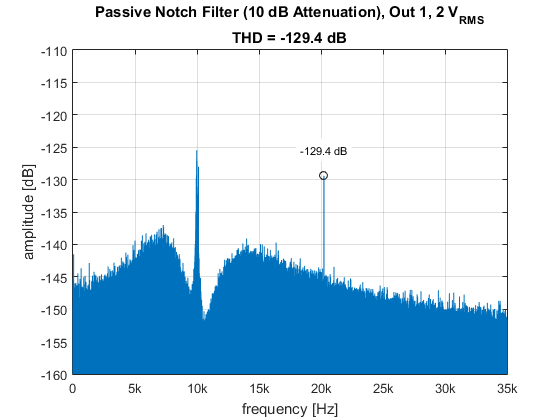
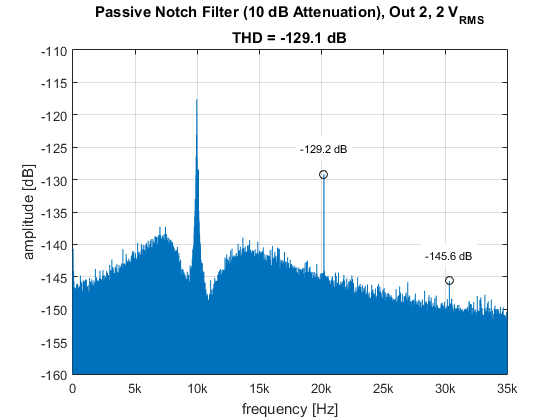
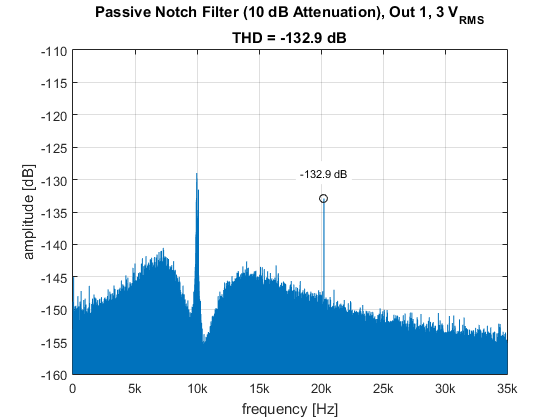
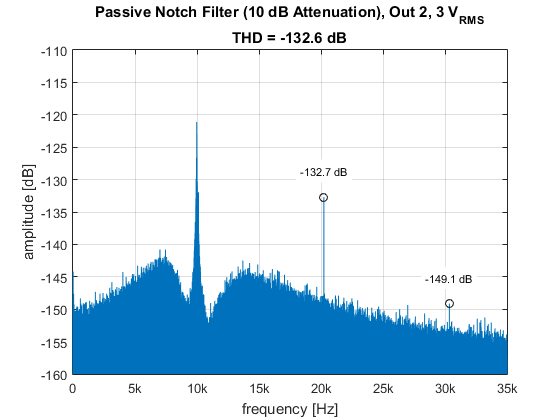
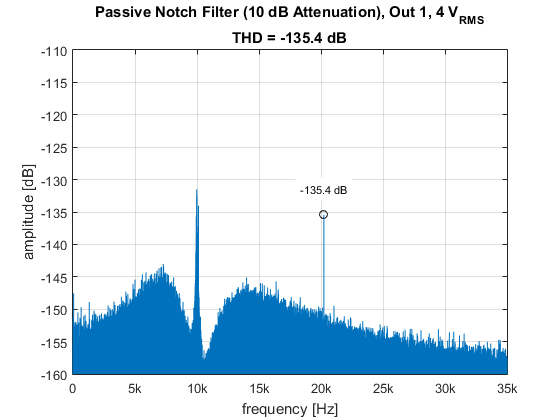
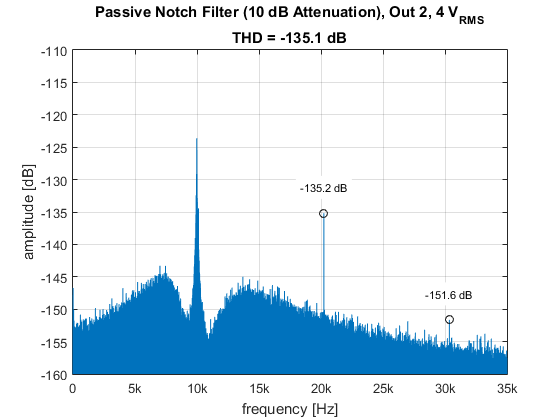
As you can see, even at higher levels the THD stay at extremely low !
It reach -135dB at 4Vrms giving 0.000018%...
Regards.
Frex
Hi all,
Here below, the Samuel measurements he has done on the EOSC10kV3 oscillator at higher amplitude level (2,3 and 4Vrms single-ended mode).
All are done using a passive notch filter with the notch response compensation included in analyzer. All level are refereed to the fundamental.






As you can see, even at higher levels the THD stay at extremely low !
It reach -135dB at 4Vrms giving 0.000018%...
Regards.
Frex
- Home
- Design & Build
- Equipment & Tools
- EOSC10Kv3 - LT AN67 10kHz oscillator : new updated version !
